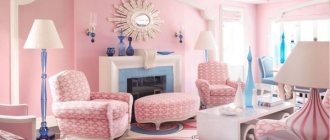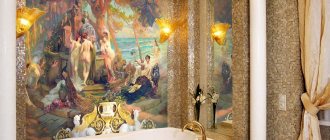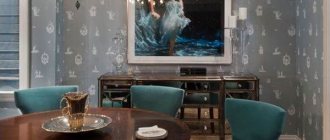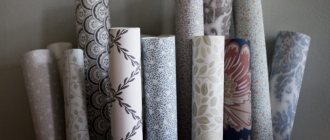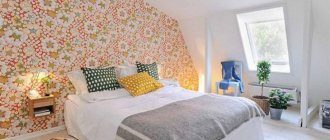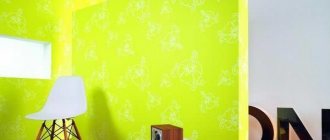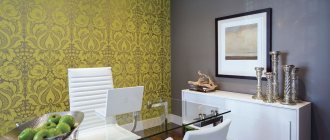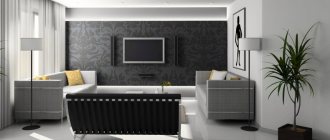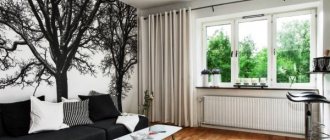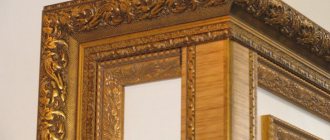Non-woven wallpaper is a popular option for decorating walls. This wallpaper has many advantages. Which ones exactly - let's figure it out below. At the same time, we’ll find out what types of non-woven wallpaper there are and how to glue them. Photos of interesting interiors with non-woven wallpaper are attached.
- In the bedroom
What is non-woven fabric
There are several types of wallpaper that contain non-woven fabric. This is a material produced by a non-woven method, consisting of 70% cellulose fibers (paper) and binders (30%). It looks like paper, but feels like fabric. It is obtained by pressing.
This material has been known for a long time and is widely used in various fields. For example, in the clothing industry. The clothing parts are glued with non-woven fabric for strength and shape retention. It is environmentally friendly, has good air permeability, and has many other high characteristics.
Advantages and disadvantages
There are pros and cons of non-woven wallpaper that must be taken into account when choosing these finishing materials. Non-woven paper differs from regular paper:
- high strength;
- wear resistance;
- denser texture;
- ease of gluing to the surface;
- the ability to mask minor defects and cracks on the surface being glued;
- ease of care;
- possibility of painting;
- fire resistance;
- moisture resistant.
Despite the higher cost than paper wallpaper, non-woven wallpaper is more profitable to buy due to its long service life. They form a durable coating, and when pasting surfaces they do not tear like paper.
These products are distinguished by a wide choice of designs, because various additional materials and technological processes are used for their manufacture.
Minuses:
- high price;
- raised surfaces require regular careful cleaning from accumulated dust;
- Some products have relief designs that are subject to mechanical damage and require careful handling;
- For gluing non-woven wallpaper immediately before painting, additional paint costs are required.
Kinds
All types of non-woven wallpaper are made from vinyl using various technologies.
- Foamed vinyl wallpaper has an unusual structure. Their density is not so high. They have small pores. Such wallpapers are breathable. Despite the fact that they are porous, non-woven fabric does not allow water to penetrate. This wallpaper is ideal for hanging in the rooms of an apartment or house.
- Smooth vinyl wallpaper. This type of wallpaper is great for hanging in the kitchen. They are denser in structure than foam wallpaper. More resistant to water and external influences.
- Wallpaper with silk-screen printing. They are very beautiful. The hot stamping method is used in the production of these non-woven wallpapers. The paper is impregnated with vinyl under pressure and the wallpaper turns out to look like silk. This wallpaper can be washed. They are environmentally friendly and durable. But their price is very high.
The photo of non-woven wallpaper shows a variety of types.
Non-woven wallpaper sizes
There are no standard sizes for these products. Each manufacturing company produces products according to its own established dimensions. Most rolls of non-woven wallpaper have the following widths:
- 53 cm;
- 70 cm;
- 90 cm;
- 1.05 m;
- 1.06 m;
- 1.4 m.
It is more convenient to store thick non-woven wallpaper in wide rolls. It is also much more convenient and faster to glue this meter-wide wallpaper. Unlike paper ones, they do not tear when exposed to moisture, they are easy to attach to an adhesive base and align on the wall.
The length of rolls of ordinary decorative wallpaper is 10 m 5 cm, and non-woven fabric for painting is often produced in rolls 12-25 m long.
How to glue non-woven wallpaper
Before gluing non-woven wallpaper, you need to prepare everything necessary for such repairs. The list includes the correct choice of wallpaper by color, pattern, and performance characteristics for the room where the renovation will be carried out. It is important to choose the right durable adhesive.
Surfaces must be prepared by thoroughly cleaning and filling all uneven areas. Small defects and cracks will be hidden under non-woven wallpaper. But noticeable recesses must be filled with putty, and the protrusions must be sanded. If the walls have been painted before, they must be cleaned of the paint layer and primed for better adhesion of the wallpaper to the surface.
The advantage is the speed of finishing with these materials - there is no need to glue the wallpaper itself. To get a strong adhesion, just apply glue to the wall, and then apply a strip of wallpaper and smooth it carefully with a roller in directions from the center to the edges.
Important: Surfaces without stains and plain colors are allowed for such wallpaper. Because they will then appear through non-woven coverings, which, due to their composition, have some transparency.
It's time to figure out what this material is and what types of coatings are on the market. We will pay special attention to companies offering the best wallpaper collections for 2021–2022.
Non-woven fabric - what is it?
Non-woven fabric is not just one specific material, but a whole class of materials united by common characteristics. All of them are non-woven, made from cellulose. Its fibers are specially treated and modified. For gluing, imparting special properties, and increasing strength, polyester is introduced into the base composition. Based on these characteristics, even ordinary paper can be classified as non-woven paper.
The name of the material comes from the German Vlieseline. registered it as an official trademark. In Russia and a number of other countries, “non-woven fabric” has become a household name. This is the name given to many materials that have a paper-like structure.
There are hundreds of varieties of non-woven fabrics in the world. Manufacturers develop their own modifiers to impart the desired properties. But the general manufacturing technology remains virtually unchanged. Modified cellulose fibers are mixed with polyester, additives and drawn into a thin ribbon. At the next stage, pressing and treatment with an adhesive solution occurs (if necessary).
Types of non-woven wallpaper
Which wallpaper is better: non-woven or paper?
Of course, there is no ready-made recipe and no strict restrictions. Each type of wallpaper has its own advantages and disadvantages (see our article “How to choose the right wallpaper”). But if you choose non-woven wallpaper, then rest assured: such wallpaper is characterized by low moisture capacity, resistance to shrinkage, fire, tensile strength and abrasion. Non-woven fabric maintains the initially specified shape. It's difficult to wrinkle. If we talk about wallpaper based on it, all existing modifications can be classified into one of the following groups:
Actually non-woven.
Layers of modified cellulose are placed on top of each other and firmly glued or soldered. The surface can be either embossed or printed. The first option is intended for further coloring.
On a non-woven basis.
A layer of paper, fabric or polyvinyl chloride (PVC) is glued on top of it. Technical characteristics are practically independent of the decorative layer. In any case, it is recommended to apply glue only to the wall.
Popular brands producing non-woven wallpaper
Non-woven wallpaper is produced in all countries.
The consumer is offered both extremely simple options, designed for a couple of years of use, and luxurious ones, designed to create special interiors. But the best non-woven wallpaper from the giants of the world of finishing materials deserve special attention. Their products are recognized by their corporate style and the nature of the design. Below is information about some of these companies.
Aquarelle (Germany)
The history of the Aquarelle brand began in 2014, and during this time 17 wallpaper collections, including non-woven ones, were released. Their peculiarity is a slightly muted, “watercolor” color scheme: smoky shades of blue, pink, silver and purple. Bright colors are possible, but as a single decor, rare inclusions.
The base of the wallpaper is non-woven, the top layer is paper or textile. Regardless of the collection, all rolls are produced with the same width - 53 cm. Preference is given to floral prints and classic stripes. But there are also completely abstract drawings. For example, in the Casa Merida collection you will find patterns that faithfully replicate the geometric shapes of ancient pyramids, exotic types of palm trees and geometric masterpieces of constructivism.
Aquarelle wallpaper is appropriate when creating an interior in the following styles: Provence.
Weightless, airy flowers and leaves will add sophistication to even a small room with the simplest furniture.
Country.
And here floral motifs would be appropriate.
They can be supplemented with canvas imitations from the same manufacturer. Casual.
This style is conquering the world.
And with the help of Aquarelle wallpaper you can get the effect of an aged surface. Colonial style.
It's time to turn to the Jaipur line and choose wallpapers with damasks, images of decks of cards, gilding and luxurious monograms.
Supporters of romanticism, art deco and other trends in interior design will also find their drawings.
ProSpero (Italy)
Wallpaper under this brand appeared on the market relatively recently. Several world-famous design bureaus are working on wallpaper design. The name ProSpero (which means “prosperous”) was not chosen in vain. Priority is given to classical motifs.
You can also find thematic collections in ProSpero wallpapers. Which non-woven wallpaper is better? It all depends on the wishes of a particular person. If you wish, you can “find yourself” on the streets of Paris or “wander” along the foggy embankments of London. Moreover, almost all surfaces feel like soft natural silk to the touch.
Jannelli & Volpi (Italy)
Initially, preference was given to plant motifs. But in recent years, design bureaus have been offering interesting interpretations of the industrial theme. Photos of skyscrapers and office building windows are presented. If you have such a desire, you can even decorate the walls of your apartment or house with stylized images of drawings or diagrams. And, of course, we can’t forget about stripes. These from Jannelli & Volpi are also distinguished by their originality. There are horizontal ones, with “cliffs” and visual distortions.
Thibaut (USA)
The Thibaut wallpaper factory is considered one of the oldest in the world. The first rolls were rolled here back in 1886. And now the company’s products are in demand on all continents. The developers are proud that there are no artificial components in the structure. The basis is only carefully processed cellulose fibers. The top layer is paper.
The factory's assortment includes wallpaper with a wide variety of designs. You can give preference to: - floral patterns (traditional or abstract); - the cage is almost Scottish; - animal prints; - stripes in combination with flowers and leaves; - completely abstract images.
The company's designers are not afraid to experiment with colors. Buyers are offered wallpaper in bright shades of red, blue, and green.
Casadeco (France)
Casadeco wallpapers feature French charm. They are intended for those who are tired of everyday life and want to bring something new and interesting to their home or apartment.
The company produces quite standard vinyl and non-woven wallpaper. But their surface structure may resemble linen and bamboo, natural leather or jute. There are also imitations of decorative plaster.
If we talk about drawings, then the consumer is practically unlimited. You can choose a photo of many hats or the ocean coast, abstract brush strokes, or an image of dozens of open and scattered boxes. Separate collections contain views of European cities and scenes on the theme of Japan.
Advantages of non-woven base
Non-woven wallpaper has the advantages of paper, but is practically free of its disadvantages. The advantages include the following points: - the canvas is quite dense, so it masks small cracks and depressions on the walls; — the base is moisture resistant; — does not absorb dirt; — the material is fire-resistant; — the pattern on the canvas is preserved for a long time. He is not afraid of even direct sunlight; - no problems with gluing - just apply glue to the wall; — the canvas retains its dimensions during operation; - no shrinkage. The last point is especially important due to the fact that wallpaper must be glued end-to-end. There is no need to be afraid that the design will cross the cracks after the paintings dry.
Non-woven wallpaper from the Hohenberger brand
Where are non-woven wallpapers used?
Thanks to the variety of structures, you can choose your own version of wallpaper for almost every room: living room, office, hall or hotel rooms.
Which non-woven wallpaper is better? When choosing a specific option, it is necessary to take into account the material and structure of the surface layer. Vinyl wallpaper on non-woven fabric.
Which wallpaper is better: vinyl or non-woven? Experts recommend combining the advantages of each material and eliminating existing disadvantages. Vinyl wallpaper can be glued in bathrooms and other rooms with constant or periodic high humidity. The outer layer will not deteriorate under the influence of high temperatures, and the inner layer will prevent the appearance of mold on the walls. Vinyl, unlike pure non-woven fabric, is difficult to scratch. In practice, this means that vinyl non-woven wallpaper can be glued in a nursery. And pets will not be able to damage them. The vinyl surface can be washed and wiped with a damp, clean cloth to remove dust. The best vinyl wallpaper on a non-woven basis is appropriate in almost all types of residential premises, hotels, and sanatoriums. They “breathe”, do not support the spread of flame and withstand children's creativity.
Paper wallpaper on a non-woven basis.
This version of finishing materials has a variety of textures and is a budget option. But the instability of paper to moisture somewhat limits the scope of their application. It is not recommended to glue such wallpaper in the kitchen or other rooms with high humidity. The best purpose is bedrooms and living rooms, subject to careful preliminary preparation of the original surfaces.
Textile wallpaper on a non-woven basis.
The combination of fabric and non-woven base is considered a “royal”, elite finishing option for walls and ceilings. Such wallpapers are used to create classic interiors in the offices of executives of large companies, and to decorate luxury apartments and mansions. Textile wallpaper looks elegant, retains its original color even in direct sunlight, and improves the heat and sound insulation of the room.
Non-woven wallpaper for painting
Paintable wallpaper can be seen on the walls of apartments, private houses, hotels, bank offices and commercial structures.
There are two main modifications of wall coverings: non-woven ones; with outer vinyl layer. The first option in most cases does not have a pronounced relief. The walls are smooth and uniform. There are no special restrictions on the type of paint. It can be water-based or latex. You can repaint up to ten times. This will not affect the color saturation in any way.
Non-woven wallpaper with an outer vinyl layer is more interesting in terms of texture. The drawings can be quite voluminous, which makes the actual painting process difficult. You can repaint no more than five times. Then you will have to change the wallpaper. But the result of decoration looks more interesting than a smooth wall.
How to prepare a wall and hang non-woven wallpaper
You need to start the process of gluing walls with the choice of glue.
You must first check the manufacturer's recommendations. They must be marked on each roll. General recommendations regarding the selection and preparation of the best adhesive for non-woven wallpaper are as follows: - base - dry modified starches; — prepare the glue before cutting the rolls. On the one hand, it must swell, on the other hand, it must not have time to crystallize; — the structure must be completely homogeneous. This will make application easier; - the glue should not have its own shade. Otherwise, it may turn yellow after drying. Another important requirement is for the glue if wallpaper is selected for painting. The adhesive composition must be chemically neutral to paint pigments.
Non-woven wallpaper from the Hohenberger brand
If the glue is selected, you can proceed to the next stages of work:
Preparing the walls.
Non-woven wallpaper can be glued to almost any surface, including concrete and wood chips. In any case, the wall must be cleaned of the old coating, and height differences of more than 10 mm per square meter must be eliminated using plaster. After drying, the surfaces are sanded and treated with a primer in two layers, with the obligatory drying of each.
Marking.
Choose a corner opposite the door. A vertical line is drawn at a distance of one meter from it. She will be the starter. Then markings are made taking into account the width of the roll (53 or 106 cm).
Open the rolls.
The floor is first washed clean or covered with film. Cut off the first strip, leaving a margin of 10–15 mm. Next, do not forget about joining the drawing, if necessary.
Applying glue to the wall using a roller or brush.
Each time you need to grab a little space for the next strip to fix the edge.
Direct pasting.
The strip is applied starting from the top and smoothed thoroughly to avoid the appearance of bubbles. If there is excess left on top or bottom, cut it off with a knife. The following strips are glued taking into account the alignment of the pattern. No overlap required.
Separately, it is worth dwelling on the design of the corners. Here two canvases are placed on top of each other based on the print. Next, the excess on each side is cut off. To avoid unevenness, the wallpaper is pressed directly in the corner with a spatula and cut through. It is recommended to coat the edges with glue again.
Interior photos
Now let's see what kind of interiors can be created using non-woven wallpaper.
Base for painting
If they are used under a paint layer, then for gluing non-woven wallpaper you need to choose a more durable special glue. If this is not done, then the wallpaper will slide down under its own weight.
You can start painting only after the wallpaper has completely dried. It is applied as with normal wall painting. It is better to use a roller to better paint over relief designs. Paints must be water-dispersed. When coated with oil, the recesses of the relief patterns become clogged and become less expressive.
Minuses
There are also disadvantages to non-woven wallpaper. After pasting the smell remains. Which can last for more than a month. But by airing this drawback can be quickly eliminated.
You need to buy only high-quality wallpaper. The disadvantages include the high cost. It's much cheaper to buy paper ones.
Caring for non-woven wallpaper
These practical, durable coverings require proper care to keep them in good condition. Regular cleaning of surfaces from dust with a soft brush or vacuum cleaner is required. Some can be washed with a damp cloth.
How to care for each type of non-woven wallpaper is indicated in the instructions for them:
- an icon in the form of 1 wave means that the surface can be cleaned with a damp sponge or rag;
- the 3-wave icon means that this wallpaper can withstand washing with a wet cloth;
- the brush image means that the wallpaper can withstand intensive cleaning with soap solutions.
Properly selected and hung non-woven wallpaper will decorate any room. This type of repair can be done without any special preparation. To choose high-quality materials that will meet all standards and retain their attractiveness for a long time, you need to choose products from well-known manufacturers. If you follow all the recommendations for caring for such products, they will look like new for a long time.
Where to begin?
- First of all, clean the surface you need from the old finish: remove old wallpaper, decorative plaster, paint. Remove all nails, bolts and sockets.
- It is best to smooth out microcracks, “sinks”, and peelings with putty and sand the surface with sandpaper. This must also be done if there are differences of more than 10 mm per 2 m.
- Prime the walls with penetrating acrylic primer. It will reduce the moisture capacity of the base and strengthen it. Carry out the work in 2 steps, taking a break of 3-4 hours between stages. Acrylic primer can be replaced with wallpaper glue diluted to a liquid state.
- Apply markings for convenience: one vertical line - at a distance of 1 meter from the corner, from the starting line - segments equal to the width of the roll, and vertical strokes for joining the wallpaper.
Advice
Reference! To remove old paint, use a medium-grained abrasive and remove dust with a special product.
The list of tools required for work includes:
- Laser level (plumb line).
- 3 meter tape measure.
- Wide metal spatula.
- Knife.
- Ditches for glue.
- Rollers (rubber - for rolling out wallpaper, with pile - for applying glue).
- A bucket for water, a foam sponge, a simple pencil, a clean towel.
